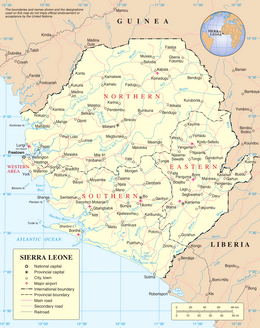
Back Операция „Барас“ Bulgarian Operación Barras Spanish Operaatio Barras Finnish Opération Barras French Operazione Barras Italian シエラレオネ人質救出作戦 Japanese 바라스 작전 Korean Operacja Barras Polish Operation Barras Swedish 巴拉斯行動 Chinese
| Operation Barras | |||||||
|---|---|---|---|---|---|---|---|
| Part of the Sierra Leone Civil War | |||||||
 A map of Sierra Leone on which is marked Freetown (the capital, to the extreme west) and the nearby towns of Hastings (where the SAS and Paras prepared for the operation) and Masiaka (where the Jordanian detachment of UNAMSIL was based) | |||||||
| |||||||
| Belligerents | |||||||
|
| West Side Boys | ||||||
| Commanders and leaders | |||||||
| John Holmes | Foday Kallay (POW) | ||||||
| Strength | |||||||
| 150[1] | 100–200[1][2] | ||||||
| Casualties and losses | |||||||
|
1 killed 12 wounded[3] |
25+ killed 18 captured[4] | ||||||
| This article is part of a series on the |
| Sierra Leone Civil War |
|---|
| Personalities |
| Armed forces |
| Key events |
| Attempts at peace |
| Political groups |
| Ethnic groups |
| See also |
Operation Barras was a British Army operation that took place in Sierra Leone on 10 September 2000, during the late stages of the nation's civil war. The operation aimed to release five British soldiers of the Royal Irish Regiment and their Sierra Leone Army (SLA) liaison officer, who were being held by a militia group known as the "West Side Boys". The soldiers were part of a patrol that was returning from a visit to Jordanian peacekeepers attached to the United Nations Mission in Sierra Leone (UNAMSIL) at Masiaka on 25 August 2000 when they turned off the main road and down a track towards the village of Magbeni. There the patrol of twelve men was overwhelmed by a large number of heavily armed rebels, taken prisoner, and transported to Gberi Bana on the opposite side of Rokel Creek.
Negotiators secured the release of six of the soldiers, but were unable to gain the freedom of the remaining five and their SLA liaison officer before the West Side Boys' demands became increasingly unrealistic. Negotiators concluded that these were delaying tactics rather than an effort to resolve the crisis. By 9 September, the soldiers had been held for over a fortnight. Fearing that the soldiers would be killed or moved to a location from which it would be more difficult to extract them, the British government authorised an assault on the West Side Boys' base, to take place at dawn the following day, 10 September.
The ground operation was conducted by D Squadron, 22 Regiment Special Air Service, reinforced with a Troop from C Squadron, Special Boat Service — who assaulted Gberi Bana in a bid to extract the Royal Irish—and elements of 1st Battalion, Parachute Regiment (1 PARA), who launched a diversionary assault on Magbeni. The operation freed the five soldiers and their SLA liaison officer, as well as twenty-one Sierra Leonean civilians who had been held prisoner by the West Side Boys. At least twenty-five West Side Boys were killed in the assault, as was one British soldier, while eighteen West Side Boys—including the gang's leader, Foday Kallay—were taken prisoner and later transferred to the custody of the Sierra Leone Police. Many West Side Boys fled the area during the assault, and over 300 surrendered to UNAMSIL forces within a fortnight.
The operation restored confidence in the British forces operating in Sierra Leone, which had been undermined by the capture of the Royal Irish patrol. After the operation, the British government increased its support of UNAMSIL and its efforts to bring the civil war to an end, both politically, through the United Nations Security Council, and through the provision of staff officers to support UNAMSIL. The successful use of 1 PARA in Operation Barras influenced the creation of the Special Forces Support Group—a permanent unit, initially built around 1 PARA, whose role is to act as a force multiplier for British special forces on large or complex operations.
© MMXXIII Rich X Search. We shall prevail. All rights reserved. Rich X Search